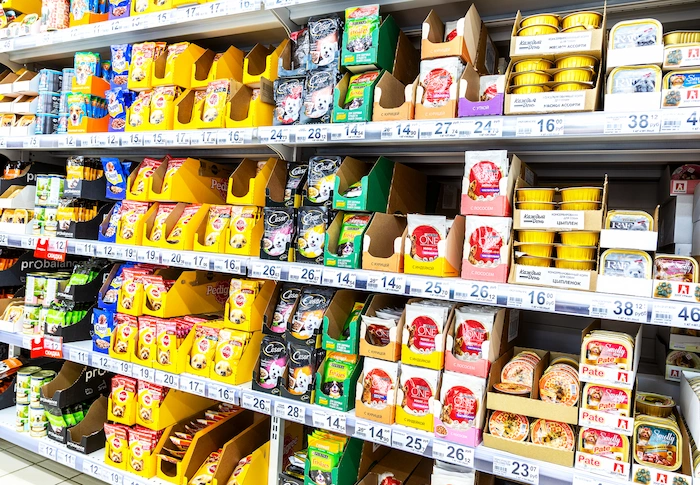Most dog owners know that underfeeding their dog can make it weak and sickly while overfeeding it can cause unhealthy weight gain, joint pain, and health concerns such as diabetes and heart conditions. However, many disagree on what exactly constitutes underfeeding and overfeeding. Such differing views can make you wonder, “How do I know how much food to feed my dog?”
This guide explains the factors behind dog nutrition and how to use dog food labels and feeding guidelines to determine how much food to feed your dog to ensure a healthy weight and minimize health issues.
Factors Affecting Your Dog’s Nutritional Needs
Your dog’s nutritional needs are determined by factors that include:
- Breed: Knowing your dog’s breed is a good way of determining how much food it should eat. Dogs from different breeds have varying digestive capabilities, metabolic rates and energy levels. For example, you may overfeed a Chihuahua if you give it the same amount of food as a German shepherd. However, breed differences don’t always translate to differences in nutritional demands.
- Size: This is a more important determinant of nutritional needs than breed. Small-breed dogs may not eat as much food or as often as large dogs. Small dogs also tend to take smaller bites than their larger counterparts. Feeding a small dog food with more calories per serving ensures it gets enough nutrients from a small bowl of food while giving a large dog nutritious food with fewer calories per serving multiple times a day ensures it can meet its daily calorie goal without overeating.
- Age: Young puppies often need more calories than adult dogs and require abundant growth nutrients such as proteins, fats, and fatty acids. Making adult dogs eat dog foods meant for puppies can result in unhealthy weight gain and other serious health problems. Providing food based on your dog’s age is thus crucial for maintaining a healthy weight.
- Activity level: More active dogs use a lot of energy when working or playing, so they need food with higher levels of proteins and fats than sedentary dogs. Senior dogs tend to move and play less and thus require foods with fewer calories than younger pups.
- Health status: Healthy, active dogs can get nutrients from different food sources. However, the American Kennel Club suggests switching to a bland diet with easily digestible foods when your pup is sick to ease digestive discomfort. Incorporate lots of proteins, fiber, and moisture into your sick dog’s food to aid its treatment and recovery.
- Special needs: Pregnant or nursing dogs eat for themselves and their puppies. Increasing meal frequency and the amount of protein and fats a pregnant or lactating dog eats can prevent malnourishment. Buying commercial dog food rich in minerals such as calcium and phosphorus can help nursing dogs create enough milk for their pups.
Understanding Dog Food Labels
The types of dog food your pup eats determine the quantity it should eat to derive maximum nutritional benefit.
Kibble is a common dry dog food made from ground ingredients shaped into small, chewable balls. Wet food packs higher quantities of proteins, fats, and minerals than kibble. It also has 65% or more water content, aiding your dog’s hydration. Raw diets consist of unprocessed, uncooked ingredients such as animal organs, muscle meat, bones, eggs, dairy, fruits, and vegetables.
Most commercial dog food manufacturers print food labels according to regulations from the Association of American Feed Control Officials (AAFCO). Such labels list ingredients in packed or canned food according to weight, with the highest-quantity ingredient at the top. AAFCO food labels also feature a guaranteed analysis outlining the amount of individual nutrients present in the food.
Dogs need basic nutrients such as proteins, carbohydrates, fats, minerals, and vitamins to support vital bodily functions. AAFCO-compliant food labels have a nutritional adequacy statement that shows the type of animal the food is for, its life stage, and the nutrient composition. An adequacy statement with the term “complete” signifies that the food has all the basic nutrients. A statement claiming the food is “balanced” means the nutrients are in the proper proportion and appropriate for a main meal.

How to Calculate the Right Amount of Food for Your Dog
Dogs derive energy from their food, so the quantity you provide determines whether they have enough energy to get through the day. Food labels usually outline the energy contained in one serving of a meal in units called calories.
A dog’s daily caloric intake should, at minimum, cover its resting energy requirements (RER), or the energy needed to support vital bodily functions such as breathing and digestion.
To calculate your pup’s RER:
- Convert its weight into kilograms. For example, a 44-pound dog weighs approximately 20 kilograms.
- Raise this number to the power of 3/4 or 0.75. The weight of a 20-kilogram dog raised to the power of 3/4 is approximately 9.5.
- Multiply the result by 70 to get the RER. The RER of a 20-kilogram dog is 665, which means it needs to eat at least 665 calories daily to maintain essential bodily functions.
Multiplying the RER by the appropriate factor produces the daily calories your dog should eat to get the energy to move, play and learn. These factors account for variables such as a dog’s age, activity level and health goals. If the dog in our example is a neutered adult, its RER is multiplied by 1.6. Consequently, the dog needs to get 1,064 calories from its daily meals.
Remember, the calories in your dog’s treats and snacks contribute to its overall calorie intake. Effective training programs, such as the ones offered when you purchase the Halo Collar wireless fence, encourage using small, low-calorie dog treats to not exceed your pup’s calorie goals.
Feeding Guidelines on Dog Food Packaging
Commercial meals usually feature dog feeding charts on the packaging outlining the serving quantity based on a dog’s weight and age. However, following the guidelines on a dog feeding chart can affect your dog’s health if it has a low activity level or eats a lot of dog treats and snacks.
Putting the details of your pup’s weight, physical condition, and treat intake into an online calorie calculator will help you arrive at a more accurate feeding amount.
The Role of Your Veterinarian
Working with a vet reduces the trial and error of determining how much food to feed your dog. Your vet uses their dog health knowledge to recommend how many daily calories your pup needs. They’ll also suggest healthy meals based on your dog’s lifestyle and preferences.
Maintain a close relationship with your vet, informing them of any emerging eating problems or allergies to get better suggestions on meeting your pup’s nutritional needs.
Final Tips for Feeding Your Dog
Establishing a feeding routine ensures your pup is properly nourished throughout the day. It also lets you notice any issues with your dog’s meals so you can adjust the portions or change the type of food before it affects your dog’s health.
Just like humans, dogs desire variety in their meals. Incorporate different flavors and textures of healthy foods into your dog’s feeding schedule to keep it excited for mealtimes.
Above all, keep pace with the latest scientific information on dog nutrition to ensure your pup has access to the healthiest, most delicious foods on the market.
Conclusion
Feeding your pup healthy dog food gives it the energy to focus on its training and obey the gentle prompts the Halo Collar provides. Familiarize yourself with dog food labels and how to adjust the serving amounts based on your pup’s specific needs to ensure a healthy, happy dog.










